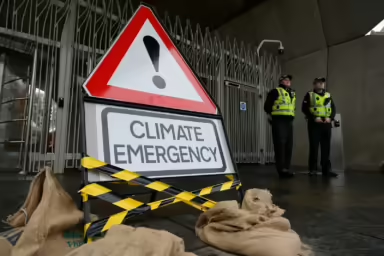To solve plastic pollution, we need nontoxic, reusable materials — not more single-use disposable products.
|
Listen To This Story
|
Acts like plastic, but made of plants? As the plastic pollution crisis grows in scale and urgency, consumer product and packaging companies are increasingly relying on so-called “bioplastics” to replace conventional fossil-fuel plastics. These bioplastics are made from many different types of ingredients, and it can be hard to keep up with all the developments. But we ignore them at our peril.
The most popular type of bioplastic made today is PLA, or polylactic acid, made from corn or sugarcane.
Performing similarly to conventional plastics, PLA is commonly marketed as a compostable, plant-based material well suited for single-use products like cups, cutlery, and takeout containers. In the hospitality industry, where the use of single-use products is prevalent, the shift toward bioplastics is seen as a step toward sustainability. Yet this “green” alternative is not as environmentally friendly or healthy as it seems.
A new report from our organization, Plastic Pollution Coalition, and the environmental research group Eunomia takes a closer look at the production and disposal processes for PLA and reveals that these sustainability claims are often overstated and run the risk of contributing to greenwashing. In reality PLA is harmful to people and the planet in ways similar to conventional fossil-fuel plastics.
Bioplastics like PLA are developed from feedstocks that often use intensive agricultural practices, which contribute to ecological problems like deforestation, water pollution, soil degradation, loss of biodiversity, and displacement of Indigenous peoples and foods. While bioplastics only make up 1 percent of global plastics, they require about 800,000 hectares of arable land (nearly 2 million acres) to produce the feedstock necessary for their development. If bioplastics like PLA fully replaced plastic in packaging, their development would require 61 million hectares (235,000 square miles) of arable land, roughly equivalent to the landmass of Texas.
Being synthetic, bioplastics are produced and manufactured in industrial, typically fossil-fueled facilities that pollute air, soils, and waters and warm the climate. Industrial facilities are disproportionately built in communities that are predominantly poor, rural, Black, Indigenous, and of color. Residents of these fenceline communities face elevated health risks from chemical emissions, explosions, and fires. Like fossil fuel plastics, PLA is made and formed into small, round pellets for melting and molding into products, which easily spill into surrounding environments and communities, with serious effects on local plants and wildlife.
PLA and other bioplastics may contain thousands of chemical additives, many of which, such as hormone disruptors, are also found in conventional plastics and are harmful to human and environmental health. PLA products and pellets can contain hundreds to more than 20,000 different chemical features, many of which are toxic to living cells like those in our bodies.
Of the thousands of composting facilities that exist in the United States, just 125 accept bioplastics. While bioplastics like PLA can technically biodegrade, composting is only possible at a few carefully controlled, high-temperature industrial facilities. PLA does not break down at the same speed as other organic materials in composting facilities, which can lead to contamination of the final compost product. In fact, some composting facilities do not accept any bioplastics due to contamination issues.
What’s more, PLA’s marketed biodegradability can confuse consumers into thinking it’s home-compostable or can be safely tossed into the natural environment. It can’t.
While the PLA industry claims its bioplastic is recyclable, at current quantities the cost and complexity of sorting and recycling the low volume of PLA in the market render it economically unfeasible. Even when PLA is recycled, like conventional plastics, it produces a downgraded product that requires additional input of feedstocks and additives to be usable. This remains in contrast to infinitely recyclable materials like aluminum, glass, and paper, which do not deteriorate in quality and can retain their value through an infinite number of recycling loops.
When PLA is landfilled or enters the environment, which is where it most frequently goes, it fragments into chemical-laced microplastics that pervade our environment and contaminate food and water. About 90,000 tons of PLA products — including packaging, food service ware, and other single-use products — were discarded as US waste in 2018 alone. Such pollution will only rise with continued PLA production, which grew from about 200,000 tons in 2015 to 300,000 tons globally in 2019, the most recent years for which data is available. Complicating our understanding of PLA production is a lack of industry transparency and the prevalence of forward-looking industry statements. Such statements are based on assumptions, not tangible data, designed to please investors, and mislead the public without substantiation.
Finally, PLA perpetuates the same single-use mindsets and systems that cause plastic pollution in the first place.
To solve plastic pollution, we need plastic-free, nontoxic, reusable, and refillable materials and systems that eliminate wastefulness — not more wasteful single-use synthetic materials like PLA.
Bioplastics are not the solution. Combating plastic pollution does not mean using more biodegradable and compostable plastics, but rather:
- Eliminating single-use products and systems and building regenerative markets around values of reusing, refilling, repairing, and sharing.
- Shifting the approach from substituting conventional plastics with bioplastics to significantly reducing plastics production and increasing use of more circular materials to promote long-term sustainability.
- Prioritizing the use of materials with infinite recyclability, such as aluminum, glass, and paper to maintain resource value and reduce waste through endless recycling loops.
- Improving our national recycling infrastructure to collect and manage infinitely recyclable plastic-free materials, mitigating these materials’ environmental impact
- Regulations that hold industries responsible for preventing and eliminating pollution and toxic chemicals, such as extended producer responsibility laws and the Global Plastics Treaty.
Real solutions to plastic pollution exist today. Our world must stop greenwashed false solutions and stay focused on plastic-free, nontoxic, reusable, and refillable materials and systems instead of harmful single-use synthetic materials like PLA.
This story by Julia Cohen and Erica Cirino was originally published by The Revelator and is part of Covering Climate Now, a global journalism collaboration strengthening coverage of the climate story.





